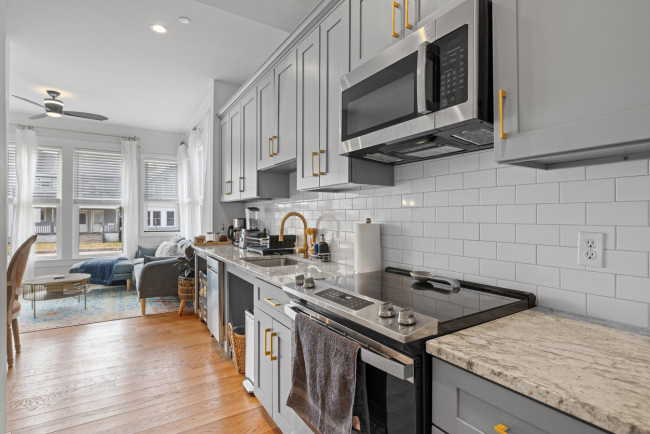How to break the lease for your NYC rental apartment
- Breaking a lease puts you at risk of losing your security deposit or covering the remaining rent
- New York landlords have a duty to mitigate damages, which means they must try to replace you

As soon as you know you want to get out of your lease, notify your landlord or management company in writing.
iStock
When you sign a lease for a New York City rental apartment, it's essential to understand that you are signing a binding contract. That means you are on the hook for the entire lease term, which typically spans 12 months but can be as long as three years.
If you need to leave your apartment before the end of the lease, you risk losing your security deposit or, even worse, having to pay the rent each month until a new tenant is found.
The reassuring news is that New York landlords have a duty to mitigate damages. As such, they must do everything possible to find another tenant at the same rent or at the current market rent, whichever is lower. Alternatively, they can opt to increase the rent in a highly competitive market (such as the existing one), thereby letting you—the original tenant—off the hook.
[Editor's note: A previous version of this story ran in August 2024. We are presenting it again with updated information for June 2025.]
This law is intended to level the playing field between renters and landlords, equally motivating both parties to find a new tenant who meets the building's income requirements and can take over the apartment's lease.
How to break your lease
Despite some challenges, there are ways to make the process work in your favor. Here are some options to stay on the right side of the law and avoid paying more than necessary.
1) Put it in writing—and find out your options
As soon as you decide to leave before the end of your lease, notify your landlord or management company in writing. A letter sent by registered mail is the typical method; however, your lease should provide specific instructions on communication. (Don't assume an email suffices.) In the termination letter, you'll want to explain your situation. Be upfront and transparent, and ask about your options.
"Some landlords will act reasonably, so always approach them first. They may ask you to find a replacement or to give them regular access to the apartment so they can show it to prospective tenants themselves," said Sam Himmelstein, a longtime tenant rights attorney at Manhattan law firm Himmelstein, Gribben & Joseph (now retired).
Given the frequency of lease breaks, many larger landlords have established general rules and procedures, while smaller, independent landlords tend to respond more on a case-by-case basis.
"Big landlords all have a process because they've been asked to do it a thousand times," said Phil Horigan, founder of Leasebreak, a free listing site for short-term rentals and lease breaks. "They'll say, 'sure, we allow it. And there's a very specific way to do it.'"
Know that "allow" does not mean "don't worry about the rent you're contractually obligated to pay." As long as there's no lost rent, you may be fine, said Rory Bolger, a broker at Brown Harris Stevens. For instance, a larger landlord may have another renter who needs to relocate.
Other landlords might let you out with a fee, while some management companies will let you break the lease penalty-free if you move into another building in their network.
The goal is to get your landlord to sign a "surrender of lease" agreement that contains language legally releasing you from the contract.
Breaking your lease can save you a lot of money, and you may want to enlist professional help to make sure you do it the most effective and safest way. The expert tenant lawyers at Outerbridge Law P.C. are an affordable way to protect yourself and get the outcome you deserve. To contact Outerbridge Law P.C. directly, call 212-364-5612 or 877-OUTERBRIDGE, or schedule a meeting today. And be sure to mention Brick Underground sent you!
2) Find another tenant to take on the lease
Even if you know someone who wants to move into your place, you're not in the clear just yet.
Most landlords want to approve new tenants, holding them to the same financial criteria and other screening processes you faced when signing the lease. These requirements typically include earning an annual salary of 40 times the monthly rent, a clean credit history, and proof of employment.
A landlord can withhold consent if they provide a valid reason for the refusal, which might be related to the new tenant's financial history or how the apartment will be used—for example, as a therapist's office.
The Met Council on Housing, a NYC tenant's rights organization, has a guide to what constitutes a reasonable or unreasonable refusal. Their site also outlines your right to suggest another qualified tenant to take your place if you intend to leave your apartment permanently, a process known as an assignment.
In this arrangement, the landlord can agree to assign the lease to the new tenant and then release you from your responsibilities. Once you submit the qualified replacement, the landlord must act within 30 days—and provide a reasonable explanation if they turn down a proposed tenant.
Under NYC housing law, you have a similar right to request to sublet your apartment if you live in a building with at least four units. Again, the landlord is required to respond to your request within 30 days—or 30 days of receiving any additional information the landlord has requested; a failure to do is considered consent by default.
With a sublet, however, you are still responsible for all the lease obligations, including the rent, according to Himmelstein.
"And if the landlord reasonably refuses to consent to the assignment—and it is often unclear what that looks like—the tenant cannot proceed with the assignment. If the landlord unreasonably refuses to consent to the sublet, then you can proceed with the subletting, but the landlord might challenge it in court," Himmelstein added.
Horigan cited another hiccup with these consent scenarios: the 30-day timeframe is impractical in a competitive rental market.
"There are few—if any—renters that can wait 30 days for a landlord to make a decision," he said. If you don't receive a response, he recommends following up with the property owner or leasing agent and attempting to work directly with them to achieve the desired outcome.
One final caveat: The right to assign your lease doesn't apply if you rent in a co-op or condo building, where you typically rent from an individual owner who is not considered a landlord under NYC law. What's more, every board has its own rules—including refusing to let an owner re-rent to a new tenant for a lease that's shorter than 12 months, or allowing only one tenant per 12-month period. Read: "My co-op board falsely accused me of illegally subletting my unit. What should I do?" for a first-hand account of what you could face if you go this route.
3) Avoid breaking your lease in winter, if possible
The slowest time for rentals is November through February or March, so breaking your lease will be more complicated during this period. First, you and your landlord will find it much easier to get a replacement tenant in the summer. Secondly, Horigan said rents can be anywhere from 10 to 30 percent lower in winter, and the landlord may have to offer more concessions to fill the place.
"Generally, an environment where rent prices are increasing is a better time to break your lease because landlords are incentivized to get new tenants sooner at higher prices," Horigan said.
But summer is also when landlords often face a higher number of vacancies due to apartment turnovers.
"If a building has five one-bedroom units available for July and you are going to throw another one in the mix, that doesn't help the landlord at all," Bolger said.
On the flip side, if your lease ends in the slower winter months and you want to break it during summer, a landlord might appreciate it if you can find a new 12-month renter with a summer start when prices are much higher. "The smaller landlords are not always thinking about this opportunity, so it can help get them to work with you," Horigan said.
Note that most people start looking for a place to rent as early as two or three months in advance. "The best starting place is to have the apartment marketed 60 days before a lease break," Bolger said.
What to know about your security deposit
As a result of changes to the rent laws in 2019, landlords must do what they can to find a tenant to replace you. The aim is to incentivize both tenants and landlords in equal measure. Therefore, your security deposit isn't necessarily at risk.
As explained by Ellen Davidson, a staff attorney at the Legal Aid Society in New York, if landlords could keep the security deposit whenever a tenant broke their lease, they would be less motivated to mitigate damages by trying to re-rent the apartment. It could be argued that landlords cannot retain your security deposit simply because you break your lease, though it might be used to cover any unpaid utility bills or damage to the apartment.
The law may also make you less likely to be sued for breaking a lease, but damages could still be imposed to cover repainting, paying a brokerage to re-rent the apartment, and lost rent—all of which might come out of your deposit.
Keep in mind that landlords need to provide you with a walk-through at the end of a tenancy, itemize any damage, allow you to make any repairs, and pay you your money back, less any repair costs, within 14 days of the tenancy end. If that isn't done, a landlord forfeits any right to your security deposit.
Know, too, that if you were offered one or two months free when you signed the lease, this perk is unlikely to be extended to the incoming tenant. If the free months are at the end of your lease term, you will likely have to forfeit them when re-renting the apartment.
And if you are tempted to recover the hefty brokerage fee you just paid when moving in, think again. "This is something I've seen recently, and while this is certainly understandable, tenants should know they are not legally allowed to charge commissions if they are not a licensed real estate agent," Horigan said.
You can, however, hire an agent to help market your apartment to renters. Horigan said part of Leasebreak's service helps match agents with tenants for this very reason. "But now, under the newly enacted FARE Act, you should be prepared to pay the agent a brokerage fee," he noted.
Be prepared to pay a penalty for breaking a lease
Even though your security deposit is likely refundable if your apartment is clean and undamaged and there is a working set of keys, you may still face a penalty for breaking your lease.
Unless you negotiated it before you began renting, a lease-break policy is unlikely to be included in your lease. If it is, however, it might lay out specific monetary penalties if the lease is broken in the slower winter months or if you're not flexible when it comes to showing the apartment to new renters.
Looking for a tenant lawyer in New York City? Altagracia Pierre-Outerbridge, Esq. has 15 years of experience litigating in Supreme, DHCR, and Housing Court. To contact Outerbridge Law P.C., call 212-364-5612 or 877-OUTERBRIDGE, or schedule a meeting today.
Adam Frisch, senior managing director at the brokerage Mantus Real Estate, employs this type of policy and said he has "very rarely had any pushback from that," noting that "most tenants appreciate that it's a flat fee in return for knowing [they] can leave."
Whether or not your lease has a lease-break policy, you may face additional fees for cleaning or painting costs. One argument against that is based on the maintenance housing code, which requires landlords to paint every three years, but Davidson said "that rule is not regularly followed" and might not hold water.
Relatedly, Horigan said landlords often do not paint and clean the apartment before the new tenant takes occupancy in a lease break situation. Instead, the apartment comes "as is."
"To avoid any confusion, you should confirm with your landlord if the apartment will be painted and cleaned before move-in so you can properly communicate this information to the incoming tenant," he said.
It's also worth investigating what your landlord is marketing your apartment for. If you were paying $2,500 and it is listed for $3,000, the landlord is violating the duty to mitigate damages. If the new rent is lower, you may have to pay the difference between your rent and the new rent.
Frisch said landlords are unlikely, in practice, to go after tenants for a few thousand dollars in lost rent—especially given some 50 percent of the lease breaks he deals with involve a tenant moving to a new city, often in a different country. "The process by which I could sue someone in Europe for $5,000 is theoretically possible though impractical, and also, it just creates resentment," he said.
What to know about the tenant blacklist
Let's say your current landlord pushes back on breaking the lease and is making demands for penalties. If you fight back and end up in NYC Housing Court, you could end up on the tenant blacklist.
Rent laws specify that landlords cannot solely use the tenant blacklist to deny someone an apartment. That means you should, in theory, not have a problem renting in another building in NYC.
In practice, though, the ban on using housing court information is riddled with loopholes and "unenforceable," said Frisch. He explained that landlords will still find ways to vet incoming tenants, and because landlords cannot take more than one month's rent as a security deposit (a common workaround for renters who do not meet the financial criteria), they are less likely to accept applicants with less-than-stellar credit scores.
How to make a case for a constructive eviction
All the above information applies to when you are moving out voluntarily, rather than because your apartment has become a living hell—or at least, what a reasonable person would consider uninhabitable.
In that scenario, you may have a case for constructive eviction, in which you claim the landlord has failed to uphold the warranty of habitability.
For example, a landlord's refusal to correct issues like bed bugs, mold, or lead paint can constitute harassment, with a specific provision in the law that enables tenants to sue for legal fees in these situations.
To claim constructive eviction, you must first vacate the premises. This is risky because if you do not prevail, you will have to pay the rent. So before you move out, be sure to build your case by taking photos of the problem and keeping a record of all efforts (in writing!) to get your landlord to resolve it.
Your detective work could also include checking with the Department of Buildings to determine if the building has any violations, if apartments have been illegally deregulated, if the building's facade is damaged, if the boiler's efficiency is low, or if the certificate of occupancy doesn't match the building's intended use.
Additionally, you may want to consult with experts to confirm the presence of mold, asbestos, or secondhand smoke.
Finally, you can call 311 or file a complaint online. If the city issues violations, that is objective proof of the condition. And violations alone may be enough to pressure your landlord into letting you out of the lease early.
—Earlier versions of this article contained reporting and writing by Emily Myers.
You Might Also Like





























